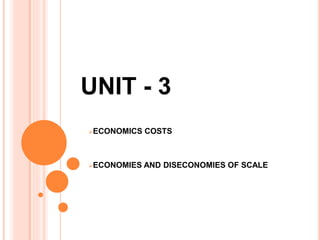
cost & economies (1).pptx
- 1. UNIT - 3 ECONOMICS COSTS ECONOMIES AND DISECONOMIES OF SCALE
- 2. The economist’s idea of cost is based on the fact that resources are scares and have alternative uses. Thus if resources are used for the production of some commodities, then it means that the production of some alternative commodities are forgone.
- 3. OPPORTUNITY COST The cost of this choice is the benefit of the next best alternative foregone. This is called opportunity cost. This choice implies sacrifice of other alternatives. hence cost of this choice will be evaluated in terms of the sacrificed alternatives. Therefore, opportunity cost is the highest valued benefit that must be sacrificed as a result of choosing alternative.
- 5. EXPLICIT COST- OUT OF POCKET COSTS The money payment, which a firm makes to those ‘outsiders’ who supply labour services, raw materials, transport services, electricity etc. are called explicit costs
- 6. IMPLICIT COST The cost of “self owned” resources Salary of proprietor Interest on entrepreneurs own investment Rent on own land
- 7. FIXED COST & VARIABLE COST SHORT RUN & LONG RUN
- 8. SHORT RUN
- 9. AVOIDABLE AND UNAVOIDABLE COST At times a firm faces a problem of retrenchment or contraction , costs which can be avoided are called as avoidable costs and costs which cannot be avoided are called as unavoidable costs.
- 10. INCREMENTAL AND SUNK COSTS Costs which increases because of expansion of a firm are called incremental costs. Cost which have to be born whether there is expansion or not are called sunk costs
- 11. IF COMPANY WANTS TO PURCHASE A MACHINE Cost of purchase Installation charges Maintenance charges Operational charges
- 12. COMMON AND TRACEABLE COSTS
- 13. HISTORICAL AND REPLACEMENT COSTS
- 14. Total fixed costs Total variable costs Total costs = Total fixed costs + Total variable costs
- 15. AVERAGE FIXED COSTS AFC= TFC/Units of output
- 16. AVERAGE VARIABLE COSTS TVC/Units of output
- 17. TOTAL AVERAGE COSTS TOTAL AVERAGE COSTS= AFC+AVC
- 18. MARGINAL COST MC= Change in total costs/ change in output
- 19. DISECONOMIES OF SMALL SCALE PRODUCTION Expenses Labour costs Wastage No real feel of market
- 20. ECONOMIES OF SCALE Internal economies are those advantages of large production which accrue to a firm on account of its superior technique and management
- 27. DISECONOMIES OF LARGE SCALE PRODUCTION As a firm expands beyond a certain limit,it becomes unmanageable and unwieldy. Management and supervision becomes difficult Labour unions Loss of coordination ( No direct contact with customers)
- 28. Overproduction Cut throat competition
- 29. Adaptation International relations
- 30. 1 TC=100+50Q-11Q2+Q3 FIND: MC,AC & AVC PROVE THAT MC PASSESS THROUGH MINIMUM POINT OF AVC
- 31. 2 TVC=50Q-10Q2+Q3 FIND THE LEVEL OF OUTPUT WHERE MC IS A MINIMUM FIND THE LEVEL OF OUTPUT WHERE AVC IS A MINIMUM
- 32. Q TC FC VC ATC AFC AVC MC 0 125 125 0 10 175 125 50 17.5 12.5 5 20 125 10.50 6.25 30 125 110 4.16 40 255 125 3.125 50 125 2.5 60 125 2.08 3 70 125 5 1.78 80 125 295 1.56
- 33. Q TC TFC TVC AFC AVC ATC MC 0 1 200 100 100 2 290 95 3 123 4 110 71 5 420 20 84 80 6 103.8 7 751 107.28 128 8 801 9 1098 998 197 10 10 123.2
- 34. Q TC TFC TVC AFC AVC ATC MC 0 100 100 1 200 100 100 100 100 200 100 2 290 100 190 50 95 145 90 3 369 100 269 33.33 89.66 123 109 4 440 100 340 25 85 110 71 5 520 100 420 20 84 104 80 6 622.8 100 522.8 16.66 87.13 103.8 102.8 7 751 100 651 14.28 93 107.28 128 8 901 100 801 12.5 100.12 112.62 150 9 1098 100 998 11.11 110.88 122 197 10 1332 100 1232 10 123.2 133.2 234
- 35. 4. For a firm, the average cost function is estimated as AC = 100/Q + 20 + 4Q What is total variable cost for the firm at an output of 15 units?
- 36. 5. If the production function is Q = 20K 0.3 L 0.3, what is the marginal rate of technical substitution of labor for capital?
- 37. 6. Which of the following cost functions signifies a long-run cost function? a. TC = 250 + 3Q b. TC = 300 c. TC = 50 + 100Q + 2Q2 d. Both (b) and (c) e. None of the above.
- 38. 7. Mr. Subba Rao, owner of Billow Garments & Brothers, employs labor and knitting machines as inputs to produce woolen garments. The following are the marginal productivity functions of labor and capital for the firm: MPK = 0.75L0.75/K0.25 , MPL = 0.75 K0.75/L0.25 If the wage paid to the laborers is Rs.8 and the cost of capital is Rs.5 each, what is the cost minimizing proportion of L to K?
- 39. 8. The production function of a firm is Q = 250L0.5. What should be the quantity of labor that the firm should hire to maximize total profits, when price of the good is Rs.2 and wage rate is Rs.25.
- 40. 9 If the total cost function is TC = 200 – 4Q + 6Q2 and the output is 4 units, what is the marginal cost ?